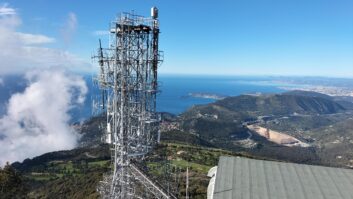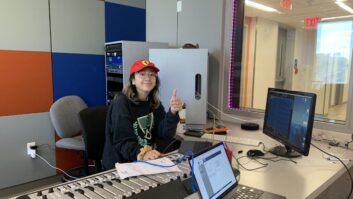WBAA-AM/FM, West Lafayette, IN – Purdue University
Jul 1, 2001 12:00 PM
A $2 million renovation underway at WBAA AM/FM, Purdue University’s NPR affiliate, will nearly double the size of the station’s studios and offices in the basement of the Elliott Hall of Music.
New studios are being built with state-of-the-art sound isolation, noise and vibration control and acoustics. Acoustical design was done by Russ Berger Design Group, Inc., of Addison, TX, while the major architectural elements (electrical, HVAC, etc.) were done by Gibralter Design of Indianapolis. The station’s director of engineering, Michael Gay, oversaw the project.
WBAA received its license in 1922, and is the longest continually operating radio station in Indiana. When the current facilities were built in the 1940s, they housed one AM station, WBAA AM 92. Companion station WBAA-FM 101.3 was launched in 1993, operating in the same space. An expansion was overdue.
The construction process has been thoroughly documented on a website put together by station manager Dan Skinner. See the progress of the project at members.home.net/wbaaconstruction.
Michael Gay took a few moments out of his busy schedule recently to give BERadio.com an overview of the project and some of the more interesting challenges that had to be met. As he notes, this is only phase one of the project.
February: View of framing from Master Control Room through studio to hall.

APRIL: New Engineering room floor.

APRIL: New Engineering Room front.

APRIL: HVAC installation.

APRIL: New studio ceiling grid.

May: Master Control Room studio framing.

June: RPG diffusers in new Master Control Room.

June: New Master control with temporary floor.

BERadio.com: What materials were used for acoustics and isolation in the Master Control Room and the Engineering Room, such as bass traps and diffusers? What kind were they, and how were they used? Were floating floors installed anywhere?
Michael Gay
: Wood diffusers were the Omniffusor from RPG Diffuser Systems. The double magnetic sealing sound isolation doors were from Industrial Acoustics Company. The wall treatment was built in place. Bass traps were designed into the ceiling and consist of a 10″ gap between the suspended ceiling and the side walls of the studios.
The studio is located in the basement of Purdue�s Elliott Hall of Music (www.purdue.edu/hlmc/venues/Elliott), one of the largest proscenium theaters in the world. A 6,025 seat auditorium in the venue is directly above the studio space for WBAA. It is not uncommon for a live concert (anything from Rap to Country to Opera) to be in progress while WBAA is broadcasting standard programming live on the air. All the studios were designed freestanding with no rigid connections between adjacent walls.
The floor, however, is not floating. It was determined that the existing 4″ slab was dense enough to make the desired sound rating. Granted, if someone outside is hammer drilling (something which will be finished soon, hopefully) you will hear and feel it, but WBAA shares the basement of Elliott Hall with the Purdue Bands. The band Practice Room is within 100 feet of the new studios. With the studios nearing completion, I heard the band practicing the other day until I walked in a studio and shut the door. Silence truly is golden.
BERadio.com: What challenges were faced in installing the HVAC? How was the system vented and installed for low-noise operation?
Michael Gay: A new low-velocity air handler was installed for the sole purpose of handling the new studio space. The existing air handling for the building would not have been sufficient. Each room has its own thermostat control and all control dampers are located at least 10 feet from the entry point into the studio to prevent any whistling or other sounds from the air rushing over the dampers. Most of the ductwork is round metal with an interior fiberglass lining, but the connection to the studios is a section of flexible duct to avoid mechanical transfer of noise.
BERadio.com: Was the original budget accurate? Were there big additions to the plans along the way?
Michael Gay: The budget was blown, as always happens in these projects. The reasoning is that a lot of dirt had to be hauled out by hand since this is an active building. This added to the labor costs. There were other overruns, too, but Purdue supported this project fully and found a way to get us additional money to make sure the project was finished properly.
BERadio.com: Is the studio wired for digital throughout? How were the cable runs handled in the floor, walls and ceiling?
Michael Gay: We had approximately an 18� by 20� section of the 4″ slab cut and removed for the new engineering center. After this, 18″ of dirt was removed by hand, slots to the studios were also cut and excavated. After all that, three 4″ conduits were laid to several 2� X 2� floor pockets located in each studio. The main engineering center, where all the automation, studio UPSs and two Logitek Audio Engines are housed, sits on a 12″ raised access floor.
Since we dug out 18″ and poured a 4″ foundation, the floor is level with the rest of the facility. Removable panels measuring 2� by 2� are used to gain access to the underfloor routing of cabling. The conduits to the studios dump out under this floor, making for a clean looking facility.
The rear wall of the room was used for 65 Siemon B-800 wiring punch blocks with black Panduit slotted surface wiring duct used to route the wall cabling. Wiring will be all-digital with an all-digital airchain for the FM and mostly digital for the AM. The FM airchain will consist of a New Audiovault II automation system with all uncompressed music on hard drives, two each of the Logitek Numix 24 and Roc-5 control surfaces and Audio Engine, SAS 16000D AES3 router, Omnia Veris digital audio processor, Mosely Starlink uncompressed STL system and finally a new Harris Digit-CD digital exciter for our existing transmitter.
The AM airchain will consist of mostly the same except for a digital Omnia 3-AM processor feeding an analog Marti STL-10 system to the transmitter site. Mic processing for all studios will consist of 14 Omnia Toolvox digital mic processors. The phone system will be the new Telos 2X12 system with AES/EBU ins and outs. We went with 30″ deep racks so we could still shut the door even after everything was wired. Equipment such as STLs and audio processors always seem to be the deepest items in a rack.
The engineering room will be a real showpiece. It will be the only engineering room I know of with track lighting to highlight the equipment in the racks. There is some overhead conduit which will be used for the new edit suites due to be completed during the next phase of the project, slated to get underway in July.
BERadio.com: What grounding system was used?
Michael Gay: The University has a master grounding system for the campus, to which all 13 Middle Atlantic Equipment Racks will be bonded using Middle Atlantic Bus Bars. Then, 2″ copper strap will be run to each studio for the playback equipment.
BERadio.com: What was it like working with Russ Berger? What kind of interesting suggestions did they have for the project? Where did Russ Berger leave off and Gibralter Design pick up?
Michael Gay: Russ Berger Design acted as the main acoustic space designers, while Gibralter handled the mechanical details, such as electrical, air handling and plumbing. We worked with Richard Schrag of Russ Berger Design Group, and he was a pleasure to work with. Russ Berger Design was able to come up with a plan to fit a very generic space in one of the worst locations for a radio studio on campus, below a 6,025 seat auditorium and adjacent to the Purdue Band�s practice room.
One of the ideas they had that we really liked was the fact that the glass between the voice studio and the control room goes all the way to the ground, giving the illusion of a large open space. Russ Berger Design also chose all the finishes for the facility, selecting an antique green scheme which will reflect the history of the oldest radio station in Indiana.
BERadio.com: Who was instrumental in the project, and what did they do? What was your role, and Dan Skinner’s role?
Michael Gay: I would have to say that Purdue�s upper administration was very instrumental and supportive of the project and helped provide the funding. There has been a change in the administration since the retirement of Purdue�s President, but the feeling toward the radio station has not changed; if anything, it has gotten better.
My role as manager of engineering was to come up with the equipment system design for the facility based on the needs of Dan Skinner and his staff. Early in the construction, my role was to work with the contractor to make sure that the intent of the plans was met and that crucial floor cuts were in the proper place to match up with our drawings from Mager Systems for the studio furniture. Several meetings were held to determine the needs and equipment was evaluated for its suitability. I put together all the drawings and wiring schemes. Currently, my role is to implement that system. I am a working manager, so I just spent the last three weeks installing racks and punching down wires. I have a staff of 11 qualified people whose normal duties are to support campus video networks and classroom technology. They have all been participating in this installation to make sure it happens according to a rather aggressive schedule.
Dan has been instrumental in working with the contractor and reporting the progress back to Russ Berger. This was the original need for the website and it expanded to serve interested parties and friends of the station.
BERadio.com: What is the project completion date?
Michael Gay: The project was divided into two phases to allow the station to continue operating. Phase one consists of what is currently on the website. This is building four studios and an engineering room in previously unoccupied space. On-air operations will transition during the first week of July and the old space will be cleaned out and ready for demolition by mid July. At this time, the new office complex for the station will be constructed as well as a new music library, engineering workshop and two new digital edit suites.












